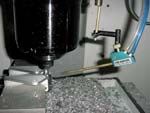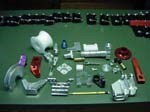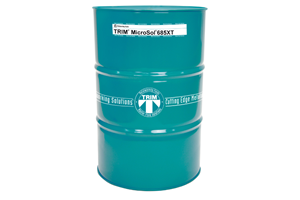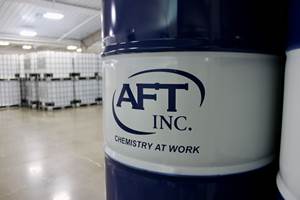Coolant Delivery System Clears The Air For Specialty Manufacturer
According to this shop owner, this coolant delivery system met his objective of minimizing coolant usage while reducing or eliminating the misting problem.
Share








Takumi USA
Featured Content
View More.png;maxWidth=45)
DMG MORI - Cincinnati
Featured Content
View MoreWard Staniforth and his wife, Ellen, had an intense interest in snowmobiles. In fact, Ellen had become the world drag racing champion in two separate classes of the winter sport. As a result of this interest, Mr. Staniforth started making special parts to enhance their snowmobile's performance. Friends and then dealers began asking him to supply them with parts, so he and his wife started their own business, WMS Enterprises (Evanston, Wyoming). In addition to a snowmobile product line, the company also manufactures parts for rock climbing equipment and for medical equipment. The shop has four CNC vertical machining centers and two CNC lathes, as well as standard milling machines and lathes.
At one point, the future of the shop seemed cloudy—literally. "Misting was a most serious problem in our shop, as a foul smelling cloud was hanging in the air," recalls Mr. Staniforth. He was aware that there have been widespread discussions about coolant delivery systems. While dry machining has been a recent trends that he was watching with interest, he saw that machines capable of milling, drilling or turning in the dry state present a very expensive alternative to flood coolant. Delivery of coolant through the spindle was also found to be very expensive. Special spindles and high pressures are often required, he learned. Regular coolant systems, which use large amounts of coolant to flood the workpiece, also presented problems in his shop. Wastes, contaminants and way lubricant were getting mixed into the coolant, necessitating an oil separation system to keep the coolant from going bad prematurely.
"Other systems we've tried in the past, such as spray coolant, released the coolant in such a fine mist that a coolant cloud can and often did develop in the shop," Mr. Staniforth says. Therefore, the challenge was to find a system that could deliver the coolant at low pressure without excessive misting.
For WMS Enterprises, the solution was a relatively new system called the Fog Buster from Hench Manufacturing Inc. (San Clemente, California). According to Mr. Staniforth, this system met his objective of minimizing coolant usage while reducing or eliminating the misting problem. The Fogbuster system is now used on the shop's CNC machines instead of the usual flood coolant. The system is adaptable to commands from the control unit and the strong airflow created works well for chip control, Mr. Staniforth says.
The system delivers coolant without fine atomization. A small stream of coolant is carried precisely to the work zone by an accurately aimed flow of air. In essence, the liquid spray is surrounded by the column of air, rather than mixed with the air, preventing the coolant from turning into a mist or a fog. This method allows the sprayer to produce a small but effective spray pattern several inches or more from its target. A precision needle valve at the sprayer head adjusts the coolant flow, an adjustment that Mr. Staniforth says is very easy to do on the shop floor.
One of the main benefits, in addition to a cleaner shop environment, is improved tool life. According to Mr. Staniforth, the cutting tools used in his shop could stand up to high temperatures and high cutting speeds but could not tolerate temperature changes, a problem he experienced even with flood coolant. Surface finish on parts also improved because the Fogbuster's accurate but strong air stream not only cooled and stabilized cutting tool and workpiece temperatures, but it also cleared chips. Finished workpieces are described as drier and cleaner.
The new coolant system operates on 10 to 20 psi and uses most types of coolant. The system comes with a 1/2 - or a 1-gallon coolant reservoir. A clear coolant bowl on the smaller model allows quick visual inspection of the coolant level, whereas the larger system comes with a sight gage. According to Mr. Staniforth, the system's quick mounting features allow it to be used on all of his machines.
Mr. Staniforth sums up his shop's experience with the non-misting coolant system: "Ellen and I breathe much easier. We save on coolant while meeting machining requirements with a system that accurately places the coolant where it is needed."
Related Content
Master Fluid Solutions Semisynthetic Coolant Inhibits Corrosion
Trim MicroSol 685XT is designed to provide enhanced corrosion inhibition on all ferrous and nonferrous metals.
Read MoreSTLE Hosts Co-Branded Tribology, Lubrication Events
The 2023 STLE Tribology Frontiers Conference and Tribology & Lubrication for E-Mobility Conference will provide attendees with two opportunities to share and learn the latest tribology and lubrication engineering science.
Read MoreBlaser Swisslube Coolant Minimizes Tool Wear When Machining Titanium
IMTS 2024: Skytec metalworking fluids are well suited for titanium machining because they minimize tool wear and reduce the number of tool changes without compromising process reliability.
Read MoreAFT's Semi-Synthetic Coolant Extends Sump Life
Advanced Cool 2200 provides high visibility while machining, keeping the machine and parts clean with no odor issues.
Read MoreRead Next
Setting Up the Building Blocks for a Digital Factory
Woodward Inc. spent over a year developing an API to connect machines to its digital factory. Caron Engineering’s MiConnect has cut most of this process while also granting the shop greater access to machine information.
Read MoreRegistration Now Open for the Precision Machining Technology Show (PMTS) 2025
The precision machining industry’s premier event returns to Cleveland, OH, April 1-3.
Read MoreBuilding Out a Foundation for Student Machinists
Autodesk and Haas have teamed up to produce an introductory course for students that covers the basics of CAD, CAM and CNC while providing them with a portfolio part.
Read More

















































